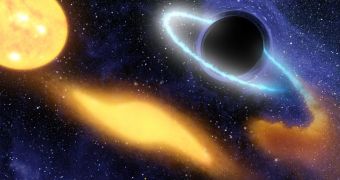Theory says that black holes are objects of extreme mass and density, having powerful gravitational fields able to warp space and time, and surrounded by a boundary called the event horizon, beyond which matter and energy cannot escape the gravitational pull and will ultimately fall in the singularity. In addition to this, in the 1970s, Stephen Hawking stated that black holes were not entirely black, meaning that they did emit some form of energy through the event horizon into the surrounding medium.
This energy emission is called Hawking radiation; if given enough time, black holes could evaporate out of existence through this type of radiation. The same theory also says that most of the black holes will outlive the universe, because this radiation emission is taking place at a very slow rate. A team of researchers from the University of St. Andrews and the University of Nice has recently simulated an event horizon, in order to test Hawking's theory that black holes are, in fact, not black.
The researchers accomplished this by creating a channel of flowing water. The analogy is that flowing water falling under the action of gravity cannot escape and flow upwards, just as energy falling into a black hole cannot escape the gravitational pull of the singularity and exit through the event horizon. Nonetheless, Stephen Hawking showed that it could be indeed possible.
Water flowing down a channel will always have a greater speed than waves. The experimental rig was specially designed so that waves of different speed and wavelength could be sent against the current - the experiment was filmed with the help of a video camera to confirm Hawking's theory. "It is probably impossible to observe the hawking radiation of black holes in space, but something like the radiation of black holes can be seen on Earth, even in something as simple as flowing water," said professor Ulf Leonhardt from the School of Physics and Astronomy.
The water channel used in the experiment carried out at the Genimar laboratory measures 30 meters in length, and is fed with water on one side, while the other is specially designed to produce waves. It usually has the role of predicting and testing the impact of waves on coasts or hulls of French submarines. Anti-waves, analog to the anti-particles emitted from the black hole's event horizon, have been observed during the experiment, thus confirming for now Hawking's theory.
"Flowing water does not create anti-particles, but it may create anti-waves. Normal waves heave up and down in the direction they move, whereas anti-waves do the opposite. We definitely have observed these negative-frequency waves. These waves were tiny, but they were still significantly stronger than expected. However, our experiment does not completely agree with theory and so much work remains to be done to understand exactly what happens at the event horizon for water waves," professor Leonhardt explained.

 14 DAY TRIAL //
14 DAY TRIAL //